2023 ALFA ROMEO STELVIO wipers
[x] Cancel search: wipersPage 11 of 268

9
EXTERIOR LIGHTS ...................................43
Headlight Switch .................................... 43
Daytime Running Lights (DRLs) ............ 43
High Beam Headlights .......................... 44
Automatic Headlights ............................ 44
Flash-To-Pass ......................................... 44
Automatic High Beam Headlights —
If Equipped ............................................. 44 Parking Lights ....................................... 45
Headlight Off Delay ................................ 45
Rear Fog Lights ...................................... 45
Adaptive Headlight System —
If Equipped ............................................. 45 Turn Signals .......................................... 45
Lane Change Assist ............................... 45
INTERIOR LIGHTS ....................................45
Front Map Reading Lights ..................... 46
Interior Ambient Lighting ...................... 46
Rear Overhead Light ............................. 47
Instrument Panel Dimmer Control ........ 47
WINDSHIELD WIPERS AND WASHERS....47
Windshield Wiper Operation ................. 48
Rain Sensing Wipers.............................. 48
Rear Window Wiper/Washer................. 49
Headlamp Washers — If Equipped ....... 49
CLIMATE CONTROLS ...............................49
Automatic Dual-Zone Climate
Control System ...................................... 50
INTERIOR STORAGE AND EQUIPMENT ... 56
Glove Compartment ...............................56
Center Console .......................................56
Rear Armrest ..........................................56
Power Outlets ........................................ 57
Cigar Lighter And Ash Tray —
If Equipped .............................................58 Wireless Charging Pad —
If Equipped .............................................58
POWER WINDOWS................................... 59
Power Window Controls .........................59
Auto-Up Feature With Anti-Pinch
Protection ............................................... 59 Power Window System Initialization .....59
Wind Buffeting .......................................59
POWER SUNROOF —
IF EQUIPPED ........................................... 60
Power Sunroof ........................................ 60
Opening And Closing The Sunroof ........60
Venting Sunroof......................................61
Sunshade Operation ..............................61
Pinch Protect Feature ............................61
Re-Initialization Procedure ....................61
Sunroof Maintenance ............................61
HOOD ...................................................... 62
Opening The Hood ................................. 62
Closing The Hood ...................................62
POWER LIFTGATE ................................... 62
Opening...................................................62
Closing ....................................................64
Re-Initialization Procedure ....................65
Cargo Area Features ..............................66
GETTING TO KNOW YOUR
INSTRUMENT PANEL
INSTRUMENT PANEL FEATURES ........... 68
Instrument Cluster ............................... 68
Instrument Cluster Descriptions .......... 69
INSTRUMENT CLUSTER DISPLAY ........... 70
Instrument Cluster Display
Description ............................................. 70 Reconfigurable Instrument Cluster
Display .................................................... 70 Reconfigurable Display Items ............... 70
Customer Programmable Settings ....... 73
WARNING LIGHTS AND MESSAGES ON
THE INSTRUMENT PANEL ....................... 74
Red Warning Lights ............................... 75
Amber Warning Lights ........................... 76
Green Indicator Lights........................... 78
Blue Indicator Lights ............................. 79
Red Symbols .......................................... 79
Amber Symbols ...................................... 80
Green Symbols ...................................... 83
Blue Symbols ......................................... 84
ONBOARD DIAGNOSTIC SYSTEM ............ 84
Onboard Diagnostic System (OBD II)
Cybersecurity ......................................... 84
EMISSIONS INSPECTION AND
MAINTENANCE PROGRAMS .................... 85
23_GU_OM_EN_USC_t.book Page 9
Page 49 of 268
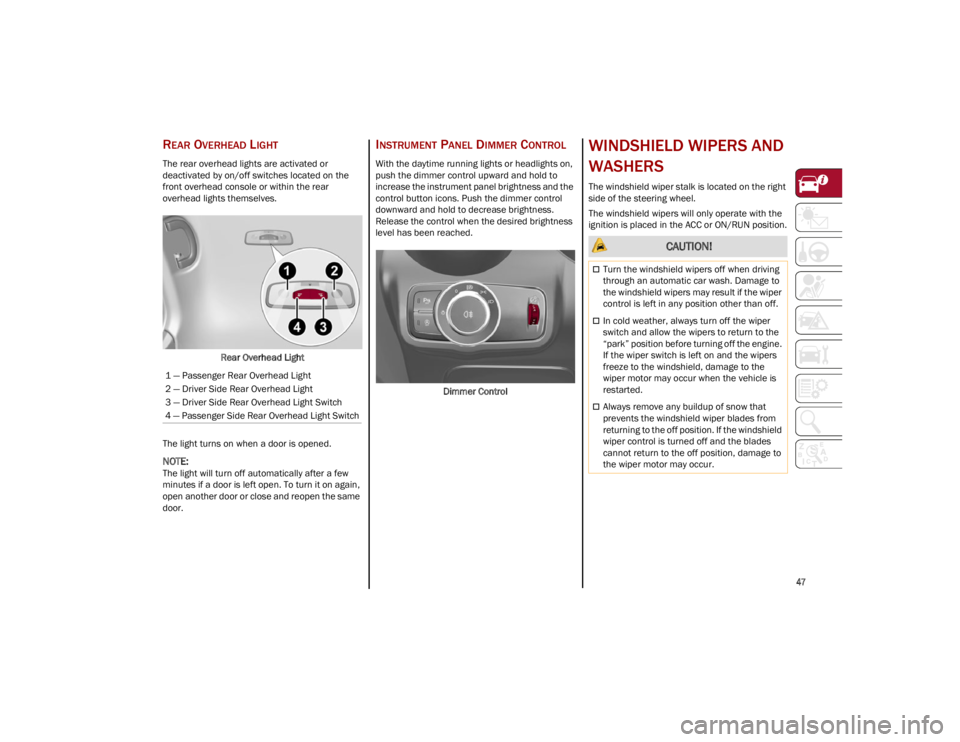
47
REAR OVERHEAD LIGHT
The rear overhead lights are activated or
deactivated by on/off switches located on the
front overhead console or within the rear
overhead lights themselves.Rear Overhead Light
The light turns on when a door is opened.
NOTE:
The light will turn off automatically after a few
minutes if a door is left open. To turn it on again,
open another door or close and reopen the same
door.
INSTRUMENT PANEL DIMMER CONTROL
With the daytime running lights or headlights on,
push the dimmer control upward and hold to
increase the instrument panel brightness and the
control button icons. Push the dimmer control
downward and hold to decrease brightness.
Release the control when the desired brightness
level has been reached.
Dimmer Control
WINDSHIELD WIPERS AND
WASHERS
The windshield wiper stalk is located on the right
side of the steering wheel.
The windshield wipers will only operate with the
ignition is placed in the ACC or ON/RUN position.
1 — Passenger Rear Overhead Light
2 — Driver Side Rear Overhead Light
3 — Driver Side Rear Overhead Light Switch
4 — Passenger Side Rear Overhead Light Switch
CAUTION!
Turn the windshield wipers off when driving
through an automatic car wash. Damage to
the windshield wipers may result if the wiper
control is left in any position other than off.
In cold weather, always turn off the wiper
switch and allow the wipers to return to the
“park” position before turning off the engine.
If the wiper switch is left on and the wipers
freeze to the windshield, damage to the
wiper motor may occur when the vehicle is
restarted.
Always remove any buildup of snow that
prevents the windshield wiper blades from
returning to the off position. If the windshield
wiper control is turned off and the blades
cannot return to the off position, damage to
the wiper motor may occur.
23_GU_OM_EN_USC_t.book Page 47
Page 50 of 268

GETTING TO KNOW YOUR VEHICLE
48
WINDSHIELD WIPER OPERATION
Rotating the switch to the Low Continuous Wiper
Speed position (2) activates the first (low) level
continuous speed of the windshield wipers in
manual mode.
Rotating the switch to the High Continuous Wiper
Speed position (1) activates the second (high)
level continuous speed of the windshield wipers
in manual mode.Windshield Wiper Stalk Rain Sensors
Rotating the switch to the Low Sensitivity Rain
Sensing position (4), activates the first, less
sensitive level of the Rain Sensing function.
Rotating the switch to the High Sensitivity Rain
Sensing position (3), activates the second, more
sensitive level of the Rain Sensing function
Ú
page 48.
Windshield Washer
To use the washer, pull the windshield wiper lever
toward the steering wheel and hold.
Both the windshield washer jet and the
windshield wiper will be activated. The wipers and
washers will continue to operate until you let go
of the lever.
The windshield wiper stops working three strokes
after the stalk is released, followed by a final
stroke six seconds later to complete the cycle.
Mist
Push the lever upward to the MIST position and
release for a single wiping cycle.
NOTE:
The Mist feature does not activate the washer
pump; therefore, no washer fluid will be sprayed
on the windshield. The wash function must be
used in order to spray the windshield with washer
fluid.
For information on wiper care and replacement,
see
Ú
page 210.
RAIN SENSING WIPERS
This feature senses rain or snowfall on the
windshield and automatically activates the
wipers. The Rain Sensor is located behind the
interior rearview mirror.
Rain Sensor
Rotate the end of the multifunction lever to one of
four settings to activate this feature.
1 — High Continuous Wiper Speed
2 — Low Continuous Wiper Speed
3 — High Sensitivity Rain Sensing
4 — Low Sensitivity Rain Sensing
5 — Windshield Wiper Off
WARNING!
Sudden loss of visibility through the
windshield could lead to a collision. You might
not see other vehicles or other obstacles. To
avoid sudden icing of the windshield during
freezing weather, warm the windshield with
the defroster before and during windshield
washer use.
23_GU_OM_EN_USC_t.book Page 48
Page 51 of 268

49
The sensor has an adjustment range that varies
progressively from wiper still (no stroke) when the
windshield is dry, to wiper at continuous speed
(fast operation) with intense rain.
Activation
Rotating the wiper switch to the Low Sensitivity
Rain Sensing position (4) or High Sensitivity Rain
Sensing position (3) activates the rain sensor.
The activation of the rain sensor system is done
by tapping the wiper stalk upwards while the
switch is in the Low Sensitivity Rain Sensing
position (4) or High Sensitivity Rain Sensing
position (3).
The variation in sensitivity during rain sensor
operation is also signaled by a stroke of the wiper.
If the windshield washer is used with the rain
sensor activated, the normal washing cycle is
performed, and then the rain sensor resumes its
normal automatic operation.
NOTE:
Keep the glass in the sensor area clean.
Deactivation
To turn off the Rain Sensing Wipers, use the wiper
switch or place the ignition in the OFF position.
In the event of malfunction of the rain sensor
while it is active, the windshield wiper operates
intermittently at a speed consistent with the
sensitivity setting of the rain sensor, whether or
not there is rain on the glass for as long as the
sensor failure is indicated on the display.The sensor continues to operate and it is
possible to set the windshield wiper to continuous
mode (1 or 2). The failure indication remains on
for as long as the sensor is active.
The rain sensor is able to recognize and automat
-
ically adjust itself in the presence of the following
conditions:
Presence of dirt on the controlled surface
(e.g. salt, dirt, etc.).
Presence of streaks of water caused by the
worn window wiper blades.
Difference between day and night.
REAR WINDOW WIPER/WASHER
Push the windshield wiper lever downward to
activate/deactivate continuous rear wiper
operation.
Push the windshield wiper lever towards the
instrument panel to activate the rear window
washer (a brief push activates one washing cycle,
keeping the stalk pushed washes continuously
until the stalk is released).
Shifting the vehicle into REVERSE with the
windshield wiper operating activates a single
cycle of the rear window wiper.
HEADLAMP WASHERS — IF EQUIPPED
The windshield wiper lever operates the headlight
washers when the ignition is in the ON position
and the headlights are turned on. To use the
headlight washers, pull the lever toward you and
release it. The headlight washers will spray a
timed high-pressure spray of washer fluid onto
each headlight lens. In addition, the windshield
washers will spray the windshield and the
windshield wipers will cycle.
NOTE:
The headlight washers work on every tenth wash
cycle request.
CLIMATE CONTROLS
The Climate Control system allows you to regulate
the temperature, air flow, and direction of air
circulating throughout the vehicle. The controls
are located on the touchscreen and on the
instrument panel below the radio.
23_GU_OM_EN_USC_t.book Page 49
Page 140 of 268
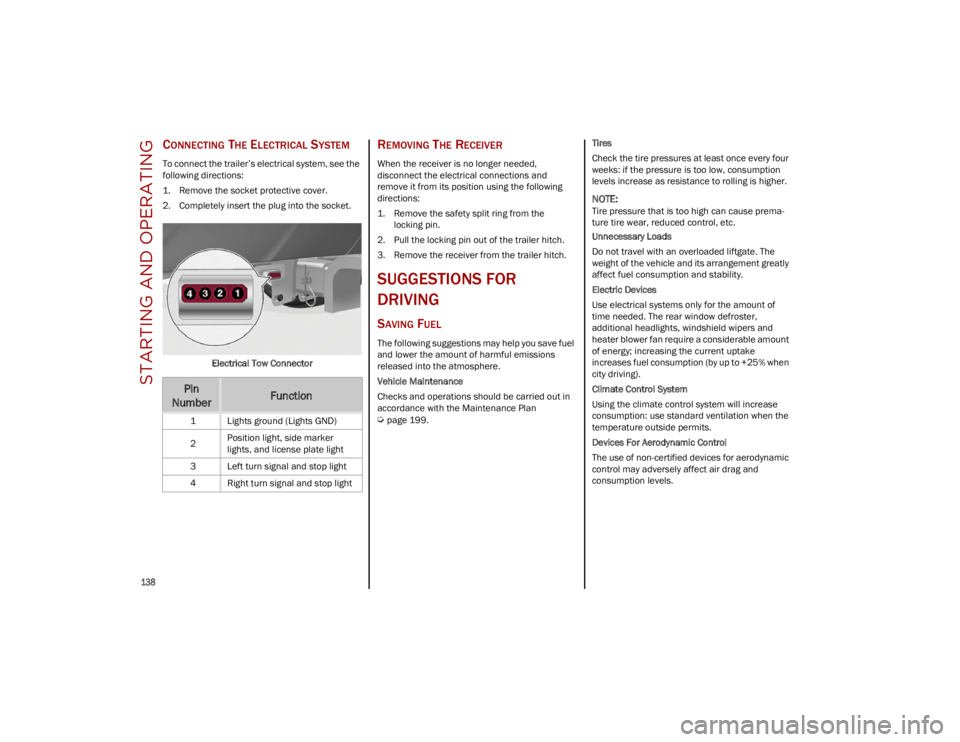
STARTING AND OPERATING
138
CONNECTING THE ELECTRICAL SYSTEM
To connect the trailer’s electrical system, see the
following directions:
1. Remove the socket protective cover.
2. Completely insert the plug into the socket.Electrical Tow Connector
REMOVING THE RECEIVER
When the receiver is no longer needed,
disconnect the electrical connections and
remove it from its position using the following
directions:
1. Remove the safety split ring from thelocking pin.
2. Pull the locking pin out of the trailer hitch.
3. Remove the receiver from the trailer hitch.
SUGGESTIONS FOR
DRIVING
SAVING FUEL
The following suggestions may help you save fuel
and lower the amount of harmful emissions
released into the atmosphere.
Vehicle Maintenance
Checks and operations should be carried out in
accordance with the Maintenance Plan
Ú
page 199. Tires
Check the tire pressures at least once every four
weeks: if the pressure is too low, consumption
levels increase as resistance to rolling is higher.
NOTE:
Tire pressure that is too high can cause prema
-
ture tire wear, reduced control, etc.
Unnecessary Loads
Do not travel with an overloaded liftgate. The
weight of the vehicle and its arrangement greatly
affect fuel consumption and stability.
Electric Devices
Use electrical systems only for the amount of
time needed. The rear window defroster,
additional headlights, windshield wipers and
heater blower fan require a considerable amount
of energy; increasing the current uptake
increases fuel consumption (by up to +25% when
city driving).
Climate Control System
Using the climate control system will increase
consumption: use standard ventilation when the
temperature outside permits.
Devices For Aerodynamic Control
The use of non-certified devices for aerodynamic
control may adversely affect air drag and
consumption levels.
Pin
NumberFunction
1 Lights ground (Lights GND)
2 Position light, side marker
lights, and license plate light
3 Left turn signal and stop light
4 Right turn signal and stop light
23_GU_OM_EN_USC_t.book Page 138
Page 212 of 268
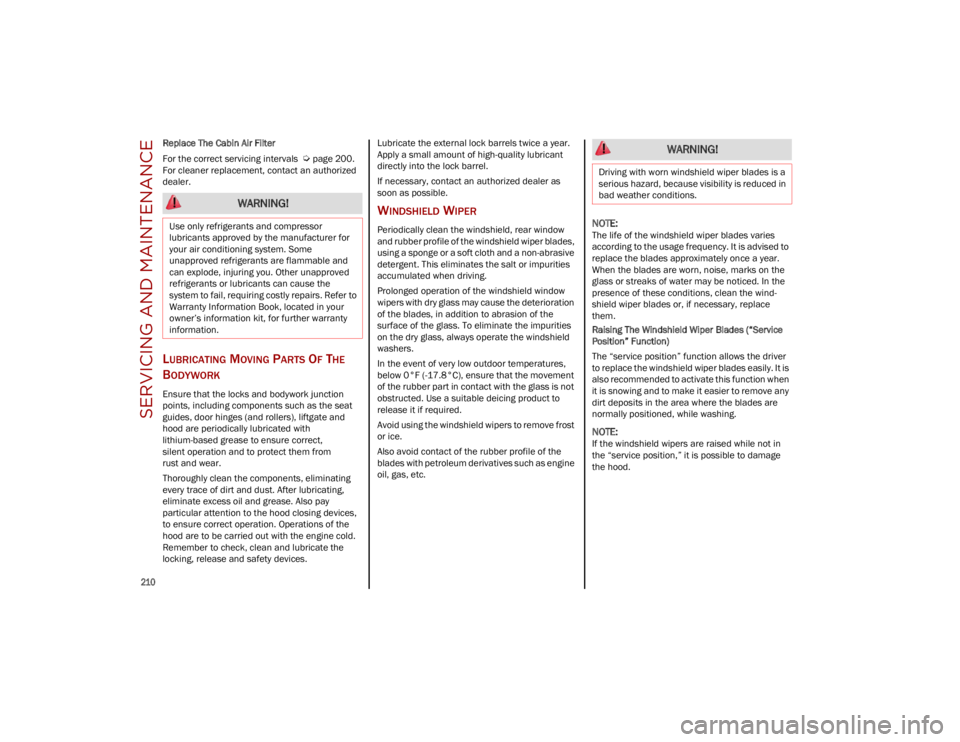
SERVICING AND MAINTENANCE
210
Replace The Cabin Air Filter
For the correct servicing intervals
Ú
page 200.
For cleaner replacement, contact an authorized
dealer.
LUBRICATING MOVING PARTS OF THE
B
ODYWORK
Ensure that the locks and bodywork junction
points, including components such as the seat
guides, door hinges (and rollers), liftgate and
hood are periodically lubricated with
lithium-based grease to ensure correct,
silent operation and to protect them from
rust and wear.
Thoroughly clean the components, eliminating
every trace of dirt and dust. After lubricating,
eliminate excess oil and grease. Also pay
particular attention to the hood closing devices,
to ensure correct operation. Operations of the
hood are to be carried out with the engine cold.
Remember to check, clean and lubricate the
locking, release and safety devices. Lubricate the external lock barrels twice a year.
Apply a small amount of high-quality lubricant
directly into the lock barrel.
If necessary, contact an authorized dealer as
soon as possible.
WINDSHIELD WIPER
Periodically clean the windshield, rear window
and rubber profile of the windshield wiper blades,
using a sponge or a soft cloth and a non-abrasive
detergent. This eliminates the salt or impurities
accumulated when driving.
Prolonged operation of the windshield window
wipers with dry glass may cause the deterioration
of the blades, in addition to abrasion of the
surface of the glass. To eliminate the impurities
on the dry glass, always operate the windshield
washers.
In the event of very low outdoor temperatures,
below 0°F (-17.8°C), ensure that the movement
of the rubber part in contact with the glass is not
obstructed. Use a suitable deicing product to
release it if required.
Avoid using the windshield wipers to remove frost
or ice.
Also avoid contact of the rubber profile of the
blades with petroleum derivatives such as engine
oil, gas, etc.
NOTE:
The life of the windshield wiper blades varies
according to the usage frequency. It is advised to
replace the blades approximately once a year.
When the blades are worn, noise, marks on the
glass or streaks of water may be noticed. In the
presence of these conditions, clean the wind
-
shield wiper blades or, if necessary, replace
them.
Raising The Windshield Wiper Blades (“Service
Position” Function)
The “service position” function allows the driver
to replace the windshield wiper blades easily. It is
also recommended to activate this function when
it is snowing and to make it easier to remove any
dirt deposits in the area where the blades are
normally positioned, while washing.
NOTE:
If the windshield wipers are raised while not in
the “service position,” it is possible to damage
the hood.
WARNING!
Use only refrigerants and compressor
lubricants approved by the manufacturer for
your air conditioning system. Some
unapproved refrigerants are flammable and
can explode, injuring you. Other unapproved
refrigerants or lubricants can cause the
system to fail, requiring costly repairs. Refer to
Warranty Information Book, located in your
owner’s information kit, for further warranty
information.
WARNING!
Driving with worn windshield wiper blades is a
serious hazard, because visibility is reduced in
bad weather conditions.
23_GU_OM_EN_USC_t.book Page 210
Page 213 of 268
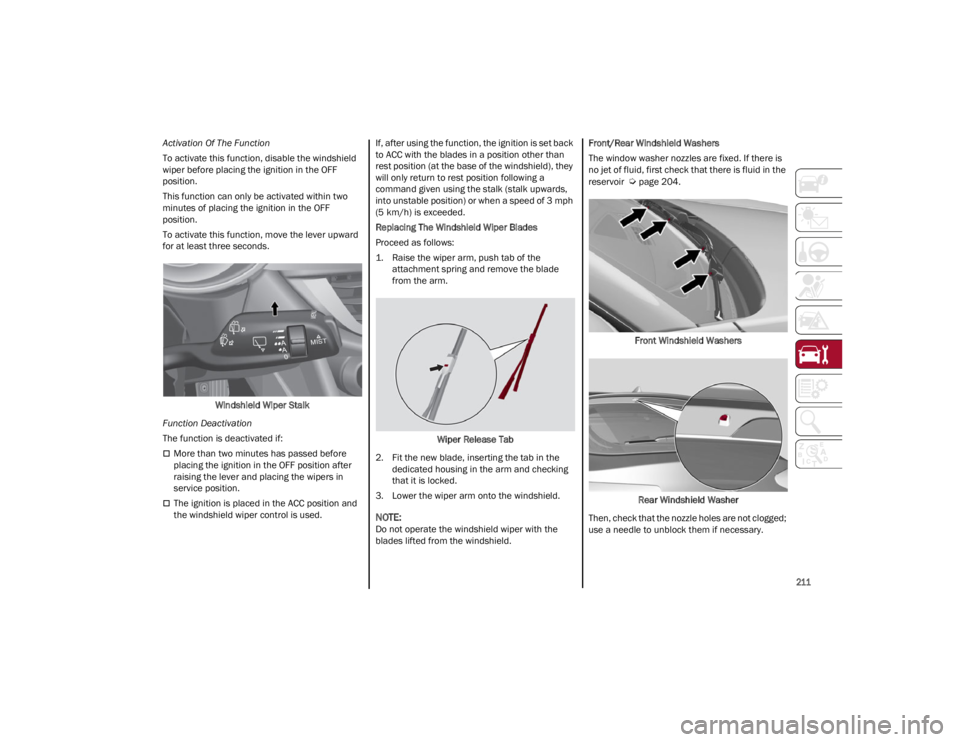
211
Activation Of The Function
To activate this function, disable the windshield
wiper before placing the ignition in the OFF
position.
This function can only be activated within two
minutes of placing the ignition in the OFF
position.
To activate this function, move the lever upward
for at least three seconds.Windshield Wiper Stalk
Function Deactivation
The function is deactivated if:
More than two minutes has passed before
placing the ignition in the OFF position after
raising the lever and placing the wipers in
service position.
The ignition is placed in the ACC position and
the windshield wiper control is used. If, after using the function, the ignition is set back
to ACC with the blades in a position other than
rest position (at the base of the windshield), they
will only return to rest position following a
command given using the stalk (stalk upwards,
into unstable position) or when a speed of 3 mph
(5 km/h) is exceeded.
Replacing The Windshield Wiper Blades
Proceed as follows:
1. Raise the wiper arm, push tab of the attachment spring and remove the blade
from the arm.
Wiper Release Tab
2. Fit the new blade, inserting the tab in the dedicated housing in the arm and checking
that it is locked.
3. Lower the wiper arm onto the windshield.
NOTE:
Do not operate the windshield wiper with the
blades lifted from the windshield. Front/Rear Windshield Washers
The window washer nozzles are fixed. If there is
no jet of fluid, first check that there is fluid in the
reservoir
Ú
page 204.
Front Windshield Washers
Rear Windshield Washer
Then, check that the nozzle holes are not clogged;
use a needle to unblock them if necessary.
23_GU_OM_EN_USC_t.book Page 211
Page 241 of 268
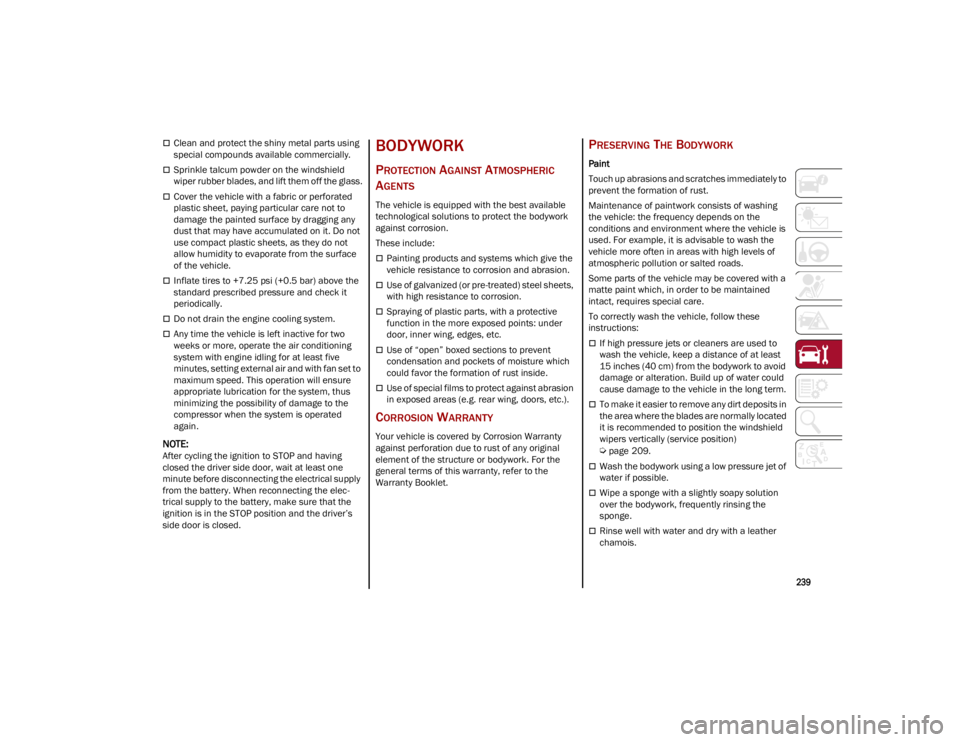
239
Clean and protect the shiny metal parts using
special compounds available commercially.
Sprinkle talcum powder on the windshield
wiper rubber blades, and lift them off the glass.
Cover the vehicle with a fabric or perforated
plastic sheet, paying particular care not to
damage the painted surface by dragging any
dust that may have accumulated on it. Do not
use compact plastic sheets, as they do not
allow humidity to evaporate from the surface
of the vehicle.
Inflate tires to +7.25 psi (+0.5 bar) above the
standard prescribed pressure and check it
periodically.
Do not drain the engine cooling system.
Any time the vehicle is left inactive for two
weeks or more, operate the air conditioning
system with engine idling for at least five
minutes, setting external air and with fan set to
maximum speed. This operation will ensure
appropriate lubrication for the system, thus
minimizing the possibility of damage to the
compressor when the system is operated
again.
NOTE:
After cycling the ignition to STOP and having
closed the driver side door, wait at least one
minute before disconnecting the electrical supply
from the battery. When reconnecting the elec-
trical supply to the battery, make sure that the
ignition is in the STOP position and the driver’s
side door is closed.
BODYWORK
PROTECTION AGAINST ATMOSPHERIC
A
GENTS
The vehicle is equipped with the best available
technological solutions to protect the bodywork
against corrosion.
These include:
Painting products and systems which give the
vehicle resistance to corrosion and abrasion.
Use of galvanized (or pre-treated) steel sheets,
with high resistance to corrosion.
Spraying of plastic parts, with a protective
function in the more exposed points: under
door, inner wing, edges, etc.
Use of “open” boxed sections to prevent
condensation and pockets of moisture which
could favor the formation of rust inside.
Use of special films to protect against abrasion
in exposed areas (e.g. rear wing, doors, etc.).
CORROSION WARRANTY
Your vehicle is covered by Corrosion Warranty
against perforation due to rust of any original
element of the structure or bodywork. For the
general terms of this warranty, refer to the
Warranty Booklet.
PRESERVING THE BODYWORK
Paint
Touch up abrasions and scratches immediately to
prevent the formation of rust.
Maintenance of paintwork consists of washing
the vehicle: the frequency depends on the
conditions and environment where the vehicle is
used. For example, it is advisable to wash the
vehicle more often in areas with high levels of
atmospheric pollution or salted roads.
Some parts of the vehicle may be covered with a
matte paint which, in order to be maintained
intact, requires special care.
To correctly wash the vehicle, follow these
instructions:
If high pressure jets or cleaners are used to
wash the vehicle, keep a distance of at least
15 inches (40 cm) from the bodywork to avoid
damage or alteration. Build up of water could
cause damage to the vehicle in the long term.
To make it easier to remove any dirt deposits in
the area where the blades are normally located
it is recommended to position the windshield
wipers vertically (service position)
Ú
page 209.
Wash the bodywork using a low pressure jet of
water if possible.
Wipe a sponge with a slightly soapy solution
over the bodywork, frequently rinsing the
sponge.
Rinse well with water and dry with a leather
chamois.
23_GU_OM_EN_USC_t.book Page 239